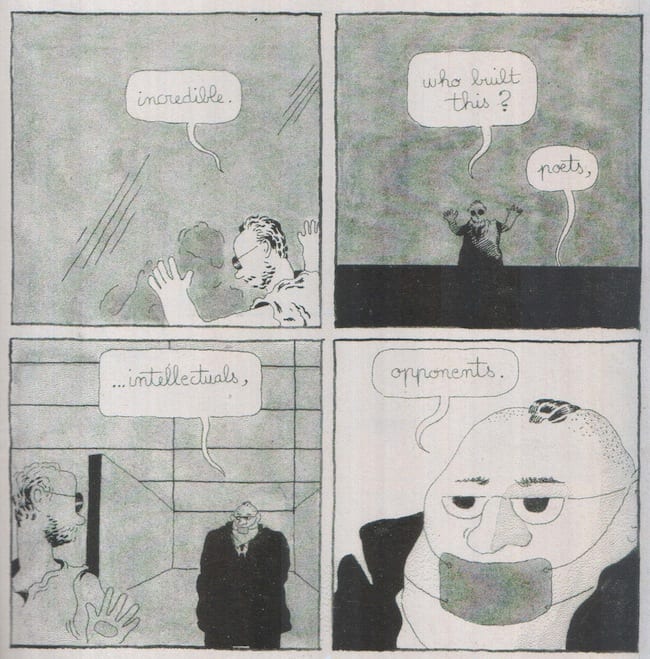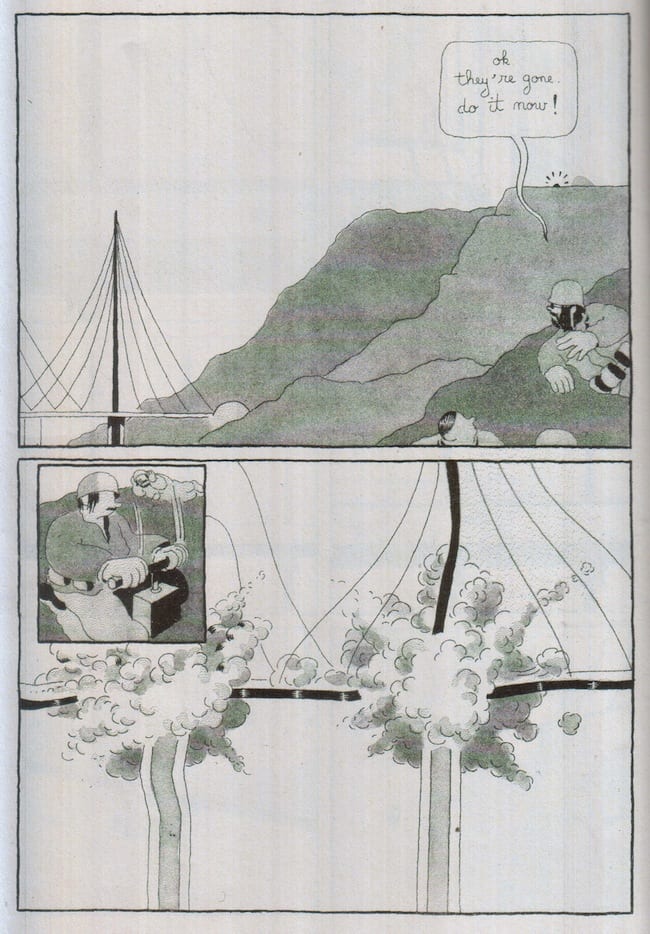Does it ever feel like you’re in a movie? That odd sense of constant performance, and constant dislocation, is exactly what this comic trades in. Throughout J.1137 a “voice-over” of sorts continues over all its parts and frames, an ongoing string of not-quite-narrative caption, muddling its many layers.

For example: the title character ("J" for short) is an actor—and an android, believable and animated as an imitation of life. He’s in a movie currently in production, and is famous for roles in others—we even spot a billboard for one, though we never learn any titles. Through all this the comic acquires a rounded sense of a world with more layers to it than a fancy cake, most of its parts smoothed together with equalizing assurances of their shared falseness. That voice-over stitching this all together acts as the prime catalyst; even after the word “Cut” it continues, seeming to shift between characters, roles, and sources. At times it even appears omniscient.
 You’d think sorting this out would prove distracting, but J.1137 exposits it all smoothly, and doesn't require careful navigation. No small feat. The book permits passive, film-like reception as well as it does analysis and picking-apart. Though that fragmented narration is the story’s key formal concession, it’s equally important that Cossé’s landscapes are so hospitable, making us happy to get lost within his world. Possibly with this in mind, Cossé pays a lot of attention to surface; he works in a billowy, deceptively pleasing line, frequently piercing immaculate compositions with suggestive, haunting architectural shapes. His achromatic watercolors are well-preserved in reproduction, retaining subtle patterns of drips and pools, and creating an aura of ambiguity. The very idea of medium is here tugged at and called into question, the printing methods suggesting something of film’s grain and texture as they iterate the scrim-like texture of the artist's paper—very little here seems stable.
You’d think sorting this out would prove distracting, but J.1137 exposits it all smoothly, and doesn't require careful navigation. No small feat. The book permits passive, film-like reception as well as it does analysis and picking-apart. Though that fragmented narration is the story’s key formal concession, it’s equally important that Cossé’s landscapes are so hospitable, making us happy to get lost within his world. Possibly with this in mind, Cossé pays a lot of attention to surface; he works in a billowy, deceptively pleasing line, frequently piercing immaculate compositions with suggestive, haunting architectural shapes. His achromatic watercolors are well-preserved in reproduction, retaining subtle patterns of drips and pools, and creating an aura of ambiguity. The very idea of medium is here tugged at and called into question, the printing methods suggesting something of film’s grain and texture as they iterate the scrim-like texture of the artist's paper—very little here seems stable.

Anchoring the book amidst these flourishes, Cossé’s figures are our guide. Pillowy and inviting but precise in their gestures, J and his associates make for convincing actors. As in most movies our investment in them is key. J may be a star, but he still has a host of problems; the story’s action starts in earnest when he abruptly abandons a shoot, venturing into a world filled with forces from which he’s always fleeing. He’s driven thereafter by a human chauffeur with a tilted mohawk, Harold, and they spend an afternoon chatting as they cruise around a vacant, eerie landscape, a pastime which soon turns dangerous.

Prompted by J’s mischievous, often naïve questions and directions, the pair stumble across a space both beautiful and novel. Once inside, J marvels at it, pressing his nose against the glass—but Harold soon informs him the place they've entered into is a prison.
This revelation gets at the heart of the story’s game, just one of many unmaskings that take place in a world with few clear answers—and one in which appearances, identities, and even spaces prove dishonest. Every piece the artist shows us pulls us (as ever) through layers of lies and fabrication, each sight taken in on J’s afternoon drive gracefully elevating the story’s stakes.

And they rise quickly—before long, J's embroiled in a shootout. But it's in this event that J's understood most fully and tragically as an unwilling actor, who despite his efforts and his privileges has little hope of escaping. It's easy here to connect with him, despite how disoriented we might be by his world's strange doublings of roles, and the ways he's made complicit in its inequalities and hazards. Secure and lush and pleasing as it can be at times, Cossé's narrative space is not afraid to wound us; it uses its own porousness—we soon find that the medium, like this prison, has no real limits or clear walls.

With this sharp climax the realities of the prison's harshness are suddenly expanded, the violence of its contents revealed as symptomatic of the comic's entire world. J and Harold do escape, but only in the most limited sense, crossing a bridge (or medium), soon ravaged, back into the world they once knew. From there, the story doesn't end—the day goes on and most everything is rendered suspect; mirrors, lenses, and car windows gloss our vision, leaving the idea of medium strained and torn into a flimsy, transparent skein. In many ways, the comic's finish comes to resemble its start and is just as blatantly false. The "voice-over" returns, now the narration of a camera truck leaving its cast behind. After that the camera fades, but the voice-over goes on and Cossé’s world doesn’t end there. This is the place we go on living.







